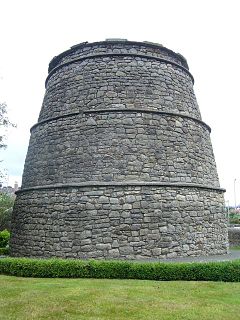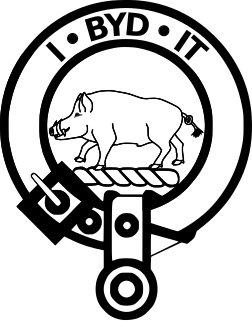Related Research Articles

The title Earl of Morton was created in the Peerage of Scotland in 1458 for James Douglas of Dalkeith. Along with it, the title Lord Aberdour was granted. This latter title is the courtesy title for the eldest son and heir to the Earl of Morton.

Earl of Gowrie is a title that has been created twice, once in the Peerage of Scotland and once in the Peerage of the United Kingdom, both times for members of the Ruthven family. It takes its name from Gowrie, a historical region and ancient province of Scotland. On 23 August 1581, William Ruthven, 4th Lord Ruthven, was created Earl of Gowrie by James VI, King of the Scots. He was executed for high treason, attainted and his peerages forfeited on 28 May 1584. Two years later in 1586, the attainder was reversed and his son, the second Earl, was restored as Earl of Gowrie and Lord Ruthven, but both peerages were forfeited after the alleged plot and subsequent death of the second Earl's younger brother, the third Earl, in 1600.

The title Lord Forrester was created in the Peerage of Scotland in 1633 for Sir George Forrester, Bt who had already been created a baronet in the Baronetage of Nova Scotia in 1625. When his only son died, Forrester was given a regrant of the peerage in 1651 with special remainders:
William Ruthven, 2nd Lord Ruthven was a Scottish nobleman. He served as an Extraordinary Lord of Session and Keeper of the Privy Seal.
Patrick Ruthven, 3rd Lord Ruthven, played an important part in the political intrigues of the 16th century Scotland. He succeeded to the lordship in December 1552. The Ruthven lordship encompassed the offices of Provost and Constable of Perth, and Sheriff of Strathearn.

The Clan Ruthven is a Lowland Scottish clan.
Sir Robert Lauder of the Bass was a Scottish knight, armiger, and Governor of the Castle at Berwick-upon-Tweed. He was also a member of the old Scottish Parliament. The Lauders held the feudal barony of The Bass, East Lothian, Edrington Castle and lands in the parish of Mordington, Berwickshire, Tyninghame in Haddingtonshire, and numerous other estates and properties elsewhere in Scotland.

Clan Nesbitt is a Scottish clan of the Scottish Borders that is recognised by the Lord Lyon King of Arms.

Dirleton is a village and civil parish in East Lothian, Scotland approximately 20 miles (32 km) east of Edinburgh on the A198. It contains 7,500 acres (30 km2). Dirleton lies between North Berwick (east), Gullane (west), Fenton Barns (south) and the Yellowcraigs nature reserve, Archerfield Estate and the Firth of Forth (north). Gullane parish was joined to Dirleton parish in 1612 by an Act of Parliament because "Golyn is ane decaying toun, and Dirleton is ane thriven place."

Dirleton Castle is a medieval fortress in the village of Dirleton, East Lothian, Scotland. It lies around 2 miles (3.2 km) west of North Berwick, and around 19 miles (31 km) east of Edinburgh. The oldest parts of the castle date to the 13th century, and it was abandoned by the end of the 17th century.

Clan Moncreiffe is a Highland Scottish clan.
Walter Campbell, 3rd of Shawfield and Islay and 9th of Skipness was a Scottish landowner, advocate and Rector of Glasgow University.
William Graham, 1st Earl of Montrose was a Scottish Lord of Parliament, who was raised to an earldom by James IV of Scotland and who died with his monarch at the Battle of Flodden.
Lord Haliburton of Dirleton was a Scottish Lordship of Parliament created circa. 1450 for Sir Walter de Haliburton, Lord High Treasurer of Scotland. The seat of Lord Haliburton was at Dirleton Castle in present-day East Lothian.
George Haliburton, 4th Lord Haliburton of Dirleton, was a Scottish Lord of Parliament.
Elizabeth Gordon, Heiress of Gordon, Scottish baroness and progenitress of the Gordon Earls and Marquesses of Huntly.
Alexander Seton, Lord Gordon was a Scottish baron, Lord of Parliament and progenitor of the Gordon Earls and Marquesses of Huntly.
The Barony of Grougar is a Scottish feudal barony which lies in north Ayrshire in the district formerly known as Cunninghame. The earliest known family likely to have owned Grougar were the De Morvilles who were there in the twelfth and thirteenth centuries before the reign of Robert the Bruce. The De Morvilles originated in Morville, Department of Manche, Normandy, arrived in England in the wake of the Norman Conquest, settled in Burg, Cumbria, and later moved to Scotland in the early 12th century where they were granted land in Ayrshire. This land grant precedes the establishment of the Register of the Great Seal of Scotland so cannot be positively confirmed. Hugo de Morville who died in 1202 was the Constable of Scotland. By the late thirteenth century the Logan family were barons of Grougar. Thorbrand de Logan baron of Grougar is recorded in 1272 and a John de Logan of Grugar may be the John Logan described as ‘one of the king of England's enemies’ in 1307 during the Wars of Independence.

The Barony of Glengarnock is a Scottish feudal barony in the county of Ayrshire in Scotland.

Dorothea Stewart, Countess of Gowrie was a Scottish aristocrat. The dates of the birth and death of Dorothea Stewart are unknown.
References
- Whitaker, J & Sons: Whitaker's Peerage: Being a Directory of Titled Persons 1905.